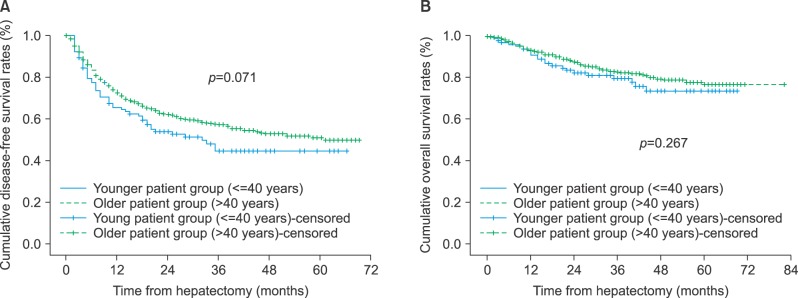Korean J Hepatobiliary Pancreat Surg.
2015 Nov;19(4):154-160. 10.14701/kjhbps.2015.19.4.154.
The prognosis in cases of hepatocellular carcinoma after hepatectomy: young patients versus older patients
- Affiliations
-
- 1Department of Surgery, Samsung Medical Center, Sungkyunkwan University School of Medicine, Seoul, Korea. yjongman21@gmail.com
- KMID: 2130967
- DOI: http://doi.org/10.14701/kjhbps.2015.19.4.154
Abstract
- BACKGROUNDS/AIMS
Hepatocellular carcinoma (HCC) is uncommon in young adults and the prognosis of these patients is still unclear. In this retrospective study, we compared the clinicopathological characteristics and outcomes of young patients with HCC with those of older patients with HCC.
METHODS
We retrospectively reviewed the clinicopathological characteristics of a total of 1,124 patients with HCC who underwent hepatectomy at our institution between 2006 and 2010. Patients < or =40 years of age at the time of HCC diagnosis were classified in the younger group.
RESULTS
One hundred and three patients (9.2%) were classified in the younger group. whereas, 1021 patients were classified in the older group. The incidences of hepatitis B virus infection, alpha-fetoprotein (AFP) levels, and indocyanine green retention test were all higher in younger patients than in older patients (p<0.05). Disease-free survival and overall survival were longer in older patients than in younger patients, without statistical significance. In younger patients, increased levels of protein induced by vitamin K antagonist-II (PIVKA-II) and alkaline phosphatase, portal vein tumor thrombosis, and intrahepatic metastasis were all predisposing factors for tumor recurrence after hepatectomy.
CONCLUSIONS
Although the AFP levels were higher in younger patients with HCC than in older patients with HCC, disease-free survival and overall survival after liver resection were not significantly different between the two groups.
Keyword
MeSH Terms
-
Alkaline Phosphatase
alpha-Fetoproteins
Carcinoma, Hepatocellular*
Causality
Diagnosis
Disease-Free Survival
Hepatectomy*
Hepatitis B virus
Humans
Incidence
Indocyanine Green
Liver
Neoplasm Metastasis
Portal Vein
Prognosis*
Recurrence
Retrospective Studies
Thrombosis
Vitamin K
Young Adult
Alkaline Phosphatase
Indocyanine Green
Vitamin K
alpha-Fetoproteins
Figure
Reference
-
1. Bosch FX, Ribes J, Díaz M, Cléries R. Primary liver cancer: worldwide incidence and trends. Gastroenterology. 2004; 127(5 Suppl 1):S5–S16. PMID: 15508102.
Article2. Gilliland FD, Hunt WC, Morris DM, Key CR. Prognostic factors for thyroid carcinoma. A population-based study of 15,698 cases from the Surveillance, Epidemiology and End Results (SEER) program 1973-1991. Cancer. 1997; 79:564–573. PMID: 9028369.3. Peres J. Advanced breast cancer in young women. J Natl Cancer Inst. 2013; 105:1257–1258. PMID: 23956454.
Article4. Yamazaki Y, Kakizaki S, Sohara N, Sato K, Takagi H, Arai H, et al. Hepatocellular carcinoma in young adults: the clinical characteristics, prognosis, and findings of a patient survival analysis. Dig Dis Sci. 2007; 52:1103–1107. PMID: 17380407.
Article5. Cho SJ, Yoon JH, Hwang SS, Lee HS. Do young hepatocellular carcinoma patients with relatively good liver function have poorer outcomes than elderly patients. J Gastroenterol Hepatol. 2007; 22:1226–1231. PMID: 17498220.
Article6. Kim JH, Choi MS, Lee H, Kim do Y, Lee JH, Koh KC, et al. Clinical features and prognosis of hepatocellular carcinoma in young patients from a hepatitis B-endemic area. J Gastroenterol Hepatol. 2006; 21:588–594. PMID: 16638104.
Article7. Chen CH, Chang TT, Cheng KS, Su WW, Yang SS, Lin HH, et al. Do young hepatocellular carcinoma patients have worse prognosis? The paradox of age as a prognostic factor in the survival of hepatocellular carcinoma patients. Liver Int. 2006; 26:766–773. PMID: 16911457.
Article8. Lam CM, Chan AO, Ho P, Ng IO, Lo CM, Liu CL, et al. Different presentation of hepatitis B-related hepatocellular carcinoma in a cohort of 1863 young and old patients - implications for screening. Aliment Pharmacol Ther. 2004; 19:771–777. PMID: 15043518.
Article9. Kim JM, Kwon CH, Joh JW, Park JB, Lee JH, Kim SJ, et al. Outcomes after curative hepatectomy in patients with non-B non-C hepatocellular carcinoma and hepatitis B virus hepatocellular carcinoma from non-cirrhotic liver. J Surg Oncol. 2014; 110:976–981. PMID: 25171344.
Article10. Kim JM, Kwon CH, Joh JW, Park JB, Lee JH, Kim SJ, et al. Differences between hepatocellular carcinoma and hepatitis B virus infection in patients with and without cirrhosis. Ann Surg Oncol. 2014; 21:458–465. PMID: 24132624.
Article11. Liver Cancer Study Group of Japan. General rules for the clinical and pathological study of primary liver cancer. 2nd ed. Tokyo: Kaneharap;2003.12. Edmondson HA, Steiner PE. Primary carcinoma of the liver: a study of 100 cases among 48,900 necropsies. Cancer. 1954; 7:462–503. PMID: 13160935.13. Korean Liver Cancer Study Group and National Cancer Center, Korea. Practice guidelines for management of hepatocellular carcinoma 2009. Korean J Hepatol. 2009; 15:391–423. PMID: 19783891.14. Chang PE, Ong WC, Lui HF, Tan CK. Is the prognosis of young patients with hepatocellular carcinoma poorer than the prognosis of older patients? A comparative analysis of clinical characteristics, prognostic features, and survival outcome. J Gastroenterol. 2008; 43:881–888. PMID: 19012042.
Article15. Takeishi K, Shirabe K, Muto J, Toshima T, Taketomi A, Maehara Y. Clinicopathological features and outcomes of young patients with hepatocellular carcinoma after hepatectomy. World J Surg. 2011; 35:1063–1071. PMID: 21380583.
Article
- Full Text Links
- Actions
-
Cited
- CITED
-
- Close
- Share
- Similar articles
-
- Prognostic Factors and Clinicopathologic Features after Resection of Small Hepatocellular Carcinoma (< or =2 cm)
- Associating microwave ablation and portal vein ligation for staged hepatectomy for the treatment of huge hepatocellular carcinoma with cirrhosis
- Application and Outcomes of Repeat Hepatectomy for Recurrent Hepatocellular Carcinom
- Two-Stage Hepatectomy for Bilateral Hepatocellular Carcinoma with Bile Duct Tumor Thrombi
- Surgical resection versus ablation for early hepatocellular carcinoma: The debate is still open


